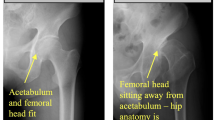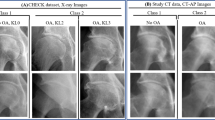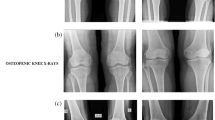Abstract
Objective
The incidence of osteoarthritis is gradually increasing in public due to aging and increase in obesity. Various imaging methods are used in the diagnosis of hip osteoarthritis, and plain pelvic radiography is the first preferred imaging method in the diagnosis of hip osteoarthritis. In this study, we aimed to develop a computer-aided diagnosis method that will help physicians for the diagnosis of hip osteoarthritis by interpreting plain pelvic radiographs.
Materials and methods
In this retrospective study, convolutional neural networks were used and transfer learning was applied with the pre-trained VGG-16 network. Our dataset consisted of 221 normal hip radiographs and 213 hip radiographs with osteoarthritis. In this study, the training of the network was performed using a total of 426 hip osteoarthritis images and a total of 442 normal pelvic images obtained by flipping the raw data set.
Results
Training results were evaluated with performance metrics such as accuracy, sensitivity, specificity, and precision calculated by using the confusion matrix. We achieved accuracy, sensitivity, specificity and precision results at 90.2%, 97.6%, 83.0%, and 84.7% respectively.
Conclusion
We achieved promising results with this computer-aided diagnosis method that we tried to develop using convolutional neural networks based on transfer learning. This method can help clinicians for the diagnosis of hip osteoarthritis while interpreting plain pelvic radiographs, also provides assistance for a second objective interpretation. It may also reduce the need for advanced imaging methods in the diagnosis of hip osteoarthritis.




Similar content being viewed by others
References
Prieto-Alhambra D, Judge A, Javaid MK, Cooper C, Diez-Perez A, Arden NK. Incidence and risk factors for clinically diagnosed knee, hip and hand osteoarthritis: influences of age, gender and osteoarthritis affecting other joints. Ann Rheum Dis. 2014 Sep;73(9):1659–64.
Yu D, Peat G, Bedson J, Jordan KP. Annual consultation incidence of osteoarthritis estimated from population-based health care data in England. Rheumatology (Oxford, England). 2015 Nov;54(11):2051–60.
Veronese N, Stubbs B, Solmi M, Smith TO, Noale M, Cooper C, et al. Association between lower limb osteoarthritis and incidence of depressive symptoms: data from the osteoarthritis initiative. Age Ageing. 2017 May;46(3):470–6.
Cross M, Smith E, Hoy D, Nolte S, Ackerman I, Fransen M, et al. The global burden of hip and knee osteoarthritis: estimates from the global burden of disease 2010 study. Ann Rheum Dis. 2014 Jul;73(7):1323–30.
Harris EC, Coggon D. HIP osteoarthritis and work. Best Pract Res Clin Rheumatol. 2015 Jun;29(3):462–82.
Gu J, Wang Z, Kuen J, Ma L, Shahroudy A, Shuai B, et al. Recent advances in convolutional neural networks. Pattern Recogn. 2018 May;77:354–77.
Anwar SM, Majid M, Qayyum A, Awais M, Alnowami M, Khan MK. Medical image analysis using convolutional neural networks: a review. J Med Syst. 2018 Nov;42(11):226.
Bernal J, Kushibar K, Asfaw DS, Valverde S, Oliver A, Martí R, et al. Deep convolutional neural networks for brain image analysis on magnetic resonance imaging: a review. Artif Intell Med. 2019 Apr;95:64–81.
Yamashita R, Nishio M, Do RKG, Togashi K. Convolutional neural networks: an overview and application in radiology. Insights into Imaging. 2018 Aug;9(4):611–29.
Anwar SM, Majid M, Qayyum A, Awais M, Alnowami M, Khan MK. Medical image analysis using convolutional neural networks: a review. J Med Syst. 2018.
Ker J, Wang L, Rao J, Lim T. Deep learning applications in medical image analysis. IEEE Access. 2017;6:9375–9.
Lindsey R, Daluiski A, Chopra S, Lachapelle A, Mozer M, Sicular S, et al. Deep neural network improves fracture detection by clinicians. Proc Natl Acad Sci U S A. 2018 Nov;115(45):11591–6.
Urakawa T, Tanaka Y, Goto S, Matsuzawa H, Watanabe K, Endo N. Detecting intertrochanteric hip fractures with orthopedist-level accuracy using a deep convolutional neural network. Skelet Radiol. 2019 Feb;48(2):239–44.
Tiulpin A, Thevenot J, Rahtu E, Lehenkari P, Saarakkala S. Automatic knee osteoarthritis diagnosis from plain radiographs: a deep learning-based approach. Sci Rep. 2018 Dec;8(1):1727.
Polat H, Danaei MH. Classification of pulmonary CT images by using hybrid 3D-deep convolutional neural network architecture. Appl Sci. 2019 Mar;9(5):940.
Yahalomi E, Chernofsky M, Werman M. Detection of distal radius fractures trained by a small set of X-ray images and faster R-CNN. In Springer: Cham; 2019. p. 971–81
Kim DH, MacKinnon T. Artificial intelligence in fracture detection: transfer learning from deep convolutional neural networks. Clin Radiol. 2018 May;73(5):439–45.
Olczak J, Fahlberg N, Maki A, Razavian AS, Jilert A, Stark A, et al. Artificial intelligence for analyzing orthopedic trauma radiographs. Acta Orthop. 2017 Nov;88(6):581–6.
Interian Y, Rideout V, Kearney VP, Gennatas E, Morin O, Cheung J, et al. Deep nets vs expert designed features in medical physics: An IMRT QA case study. Medical Physics [Internet]. 2018 Jun [cited 2020 Jan 23];45(6):2672–80. Available from: http://doi.wiley.com/10.1002/mp.12890
Fourcade A, Khonsari RH. Deep learning in medical image analysis: a third eye for doctors. Journal of Stomatology, Oral and Maxillofacial Surgery. 2019 Sep 1;120(4):279–88.
Xue Y, Zhang R, Deng Y, Chen K, Jiang T. A preliminary examination of the diagnostic value of deep learning in hip osteoarthritis. He H, editor. PLOS ONE. 2017 Jun;12(6):e0178992.
Vina ER, Kwoh CK. Epidemiology of osteoarthritis: literature update. Curr Opin Rheumatol. 2018;30(2):160–7.
Allen KD, Golightly YM. State of the evidence. Curr Opin Rheumatol. 2015 May;27(3):276–83.
Antony J, McGuinness K, Moran K, O’Connor NE. Automatic detection of knee joints and quantification of knee osteoarthritis severity using convolutional neural networks. In Springer: Cham; 2017. p. 376–90
Wong SC, Gatt A, Stamatescu V, McDonnell MD. Understanding data augmentation for classification: when to warp? In: 2016 international conference on digital image computing: techniques and applications, DICTA 2016: Institute of Electrical and Electronics Engineers Inc.; 2016.
Srivastava N, Hinton G, Krizhevsky A, Salakhutdinov R. Dropout: A Simple Way to Prevent Neural Networks from Overfitting. Vol. 15, Journal of Machine Learning Research. 2014.
Phaisangittisagul E. An Analysis of the Regularization Between L2 and Dropout in Single Hidden Layer Neural Network. In: Proceedings - International Conference on Intelligent Systems, Modelling and Simulation, ISMS. IEEE Computer Society; 2016. p. 174–179.
KELLGREN JH, LAWRENCE JS. Radiological assessment of osteo-arthrosis. Ann Rheum Dis. 1957 Dec;16(4):494–502.
Author information
Authors and Affiliations
Corresponding author
Ethics declarations
Conflict of interest
The authors declare that they have no conflicting interests.
Ethics approval
Ethical approval certificate was obtained from the Non-interventional Clinical Researches Ethics Board in Kırıkkale University. Certificate date: Aug 7th, 2019 Certificate no: 2019.07.09.
Additional information
Publisher’s note
Springer Nature remains neutral with regard to jurisdictional claims in published maps and institutional affiliations.
Rights and permissions
About this article
Cite this article
Üreten, K., Arslan, T., Gültekin, K.E. et al. Detection of hip osteoarthritis by using plain pelvic radiographs with deep learning methods. Skeletal Radiol 49, 1369–1374 (2020). https://doi.org/10.1007/s00256-020-03433-9
Received:
Revised:
Accepted:
Published:
Issue Date:
DOI: https://doi.org/10.1007/s00256-020-03433-9




